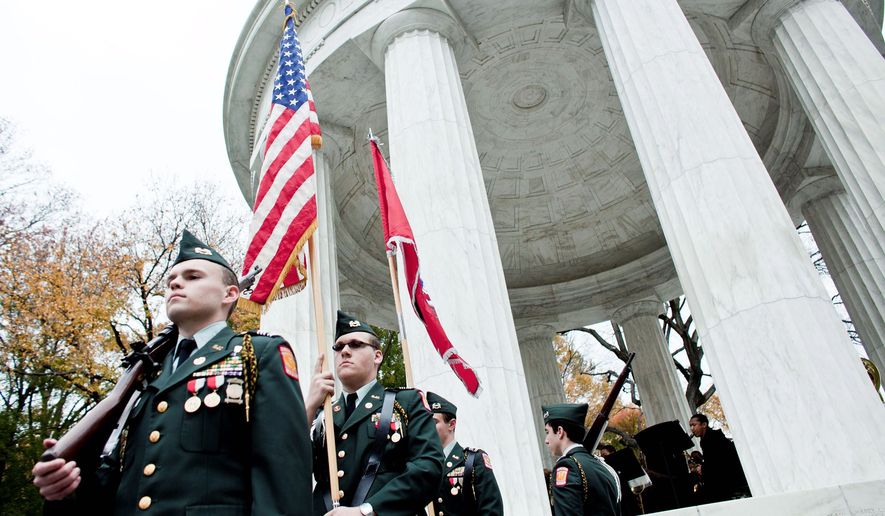Edwin L. Fountain says a teenager who walks around the Mall and takes in the ornate, circular memorial to World War II just might wonder whatever happened to World War I.
It’s a simple premise, but while three prominent conflicts of the 20th century — World War II, the Korean War and the Vietnam War — are represented in this high-traffic area of the nation’s capital, there is no national memorial to the Great War that preceded them all.
The District has a modest, long-overlooked memorial on the Mall honoring its residents who fought and died in the conflict, but no monument honors the national sacrifice.
So Mr. Fountain, a Virginia resident and board member of the World War I Memorial Foundation, is promoting legislation in Congress that would highlight the coming centennial of the 1914-18 conflict to make sure it is not marginalized in the annals of U.S. history.
The only problem is that Congress enacted a law in 2003 that essentially banned new memorials on the Mall — the dedication of the Washington, D.C. Martin Luther King, Jr. National Memorial last month marked the coda for large-scale construction.
The bills Mr. Fountain supports instead would rededicate the District of Columbia War Memorial as the “District of Columbia and National World War I Memorial.”
And that’s where it gets complicated.
The D.C. memorial is just north of the Martin Luther King Jr. memorial in West Potomac Park, tucked into a clearing about halfway between the Washington Monument and the Lincoln Memorial.
In recent years, it fell on hard times, with stained columns, broken walkways and overgrowth that made it hard to see the memorial even from nearby Independence Avenue.
The National Park Service, D.C. Mayor Vincent C. Gray and other local officials celebrated the reopening of the memorial on Thursday — in time for Veterans Day — after a yearlong, $2.3 million project to refurbish the domed, round, columned structure and conduct much-needed landscaping around the site.
Dedicated by President Hoover in 1931, the memorial honors the 26,000 D.C. residents who fought in World War I and, among them, the 499 who never made it home.
The beautification project, funded by President Obama’s federal stimulus package, restored pride in a memorial that had been neglected for too long, officials said.
Yet beneath the cordial fanfare displayed at the reopening event Thursday, a conflict brews that is fraught with local-federal tensions.
“We would never have advocated for a national memorial from scratch here on the Mall,” Mr. Fountain said near the D.C. memorial. “But because this one was here, we thought it could be appropriately rededicated.”
To put it mildly, D.C. officials are not fond of this idea. The city government has a fragile relationship with the federal government and consistently lobbies for full autonomy over its affairs and voting rights in Congress.
“That memorial was built for the people of the District of Columbia,” said Delegate Eleanor Holmes Norton, the District’s nonvoting member of Congress.
Companion bills by Sen. John D. Rockefeller IV, West Virginia Democrat, and Rep. Ted Poe, Texas Republican, also would rededicate the Liberty Memorial in Kansas City, Mo., as the “National World War I Museum and Memorial.”
Ms. Norton sounded the alarm over the D.C. portion of the legislation in August, prompting D.C. Council Chairman Kwame R. Brown to say the District “ought not stand by idly and allow our history to be diluted.”
Mr. Fountain is quick to say there is no attempt to change the character of the existing memorial. Instead, he envisions “8-foot bronzes” on either side of the structure or other, minimal adornments.
“It’s a valid debate and I respect and understand the arguments for keeping it a local memorial,” he said. “Our purpose is not to take away the local character. It’s frankly to elevate it, bring more people to this memorial, bring more attention to it — because nobody knew what this was.”
Mr. Fountain said opposition to the effort should have nothing to do with D.C. voting rights.
“Because where have they been all these years as this memorial was falling apart?” he said. “Nothing prevented the District of Columbia government from repairing this memorial. It took a federal agency spending federal funds to do it.”
The D.C. memorial is not the only site in discussions about becoming a national symbol of the Great War.
Joseph N. Grano, president of the Rhodes Tavern-D.C. Heritage Society, said the ideal place for a national memorial would be Pershing Park, which is named for World War I Gen. John J. Pershing. He circulated a photograph Thursday of “an extremely beautiful” World War I memorial in Oak Park, Ill., as an example of what an addition to the park, located on Pennsylvania Avenue about a block from the White House, could look like.
Ms. Norton used the existence of numerous World War I memorials in other states as justification for the District having its own, without making it a national version.
“If they want to have one someplace else on the Mall here, I’ll work with them,” she said as she walked from the memorial.
“If they want it here, I have no disagreement either,” she added with a smile, “so long as it doesn’t block the view of our memorial.”
• Tom Howell Jr. can be reached at thowell@washingtontimes.com.




Please read our comment policy before commenting.